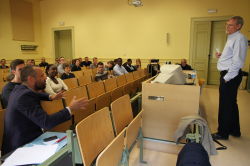
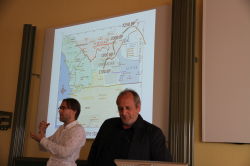
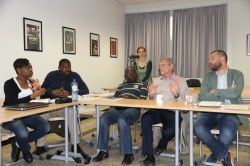
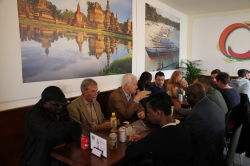
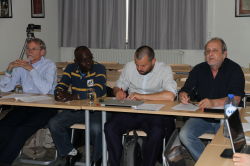

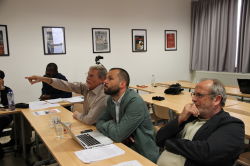
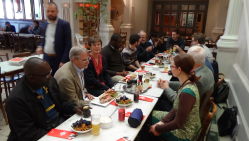
KONGOKING : Workshops
May 27-28, 2015: Workshop on Kongo history
Thematic discussion sessions
I. Origins of the Kongo kingdom:
1. Which continuities or gaps/ruptures do we see in the archaeological chrono-cultural sequence of the Lower Congo/N-Angola? (Bernard Clist)
2. How can we account for the lack of spatio-chronological continuity between "historical" times (post-1483) and "pre-historical" times (pre-1483) on major archaeological sites associated with the kingdom's history (Kindoki, Ngongo Mbata, what about Mbanza Kongo?)? (Bernard Clist)
3. Do we see evolutions in the archaeological record of the Lower Congo/N-Angola that could point towards the emergence of complex societies/polities, such as the Kongo kingdom? (Bernard Clist)
4. How can we account for the matches and mismatches between the spread and emergence of the KLC and its major sub-groups on the one hand and the chronology of the Iron Age archaeology in the Lower Congo/N-Angola on the other? (Koen Bostoen)
5. Could the Kongo kingdom/kingship have multiple origins (cf. Vungu vs. Kongo dia Nlaza debate)? (Koen Bostoen)
6. Do we see evolutions in the lexicon of KLC languages (e.g. intermediate proto-languages) that could point towards the emergence of complex societies/polities, such as the Kongo kingdom? (Birgit Riquier)
II. Centralization and Decentralization:
7. Do we have linguistic evidence for "center/periphery" effects and if so, is the center always situated in the same area (cf. spread of ngangula vs. spread prefix reduction)? Do different semantic fields testify to different patterns of linguistic diffusion? (Koen Bostoen, Sebastian Dom, Heidi Goes)
8. Can we get a better understanding of the genesis and chronology of our "Central KK"-subgroup? How and when did it emerge? Which factors contributed to its emergence? Can it be attributed to "centralizing tendencies" within the kingdom? (Gilles-Maurice de Schryver)
9. Does the archaeological record of the Lower Congo/N-Angola bear witness to centralizing effects under the influence of the kingdom? (Bernard Clist)
10. (How) did provincial mbanza sites represent the central powers and on which markers can we rely to identify mbanza sites in the archaeological record? (Igor Matonda, Bernard Clist)
11. What does the archaeological record tell us about economic integration/trade networks within and beyond the kingdom? (Bernard Clist, Nicolas Nikis)
12. Does our ethnographic knowledge of ceramic traditions in the Lower Congo/N-Angola testify to decentralizing effects subsequent to the fall of the kingdom? (Mandela Kaumba)
13. How were Christianity, language and/or material culture instrumentalized to bring about stronger centralization? (Inge Brinkman)
III. Spatial divisions and politics:
14. Do we have any new insights on how the internal constitution of the kingdom evolved through time? What do we know about the evolution of the kingdom's provinces and their increasing/decreasing independence? (Bernard Clist, Gilles-Maurice de Schryver)
15. What do we know about the internal migration of Kongo subgroups? How to explain the scattered geographic distribution of e.g. Nsundi groups/varieties? (How) is this linked with the history of the Nsundi province? (Birgit Riquier)
16. How independent/dependent were the provincial political leaders towards the powers that were in Mbanza Kongo? (Inge Brinkman)
17. What was the role of the Inkisi valley in Kongo's history? Which new insights have we acquired so far on its demography and the evolution of its mbanza's? (Igor Matonda)
IV. Kongo cosmopolitanism and the wider world:
18. Which traces does the archaeological record contain of Kongo's integration into the wider Atlantic network, (Imports: swords, pipes, etc.; Exports: pottery, pipes) (Bernard Clist)
19. Do we have historical evidence allowing to diversify/regionalize Kongo elites? (Inge Brinkman)
20. Which linguistic evidence do we have for Kongo's integration into the wider Atlantic network: Adoption and spread of European loanwords? From which languages? In which semantic fields? How (far) did they spread from the Kongo into its hinterland? (Birgit Riquier, Koen Bostoen)
21. Which archaeological and linguistic Kongo traces have been/can be recovered in the Americas? Can we tell something of the specific origins of historical Kikongo material or language sources in the Americas (e.g. Baudry des Lozières 1803)? (Gilles-Maurice de Schryver)
